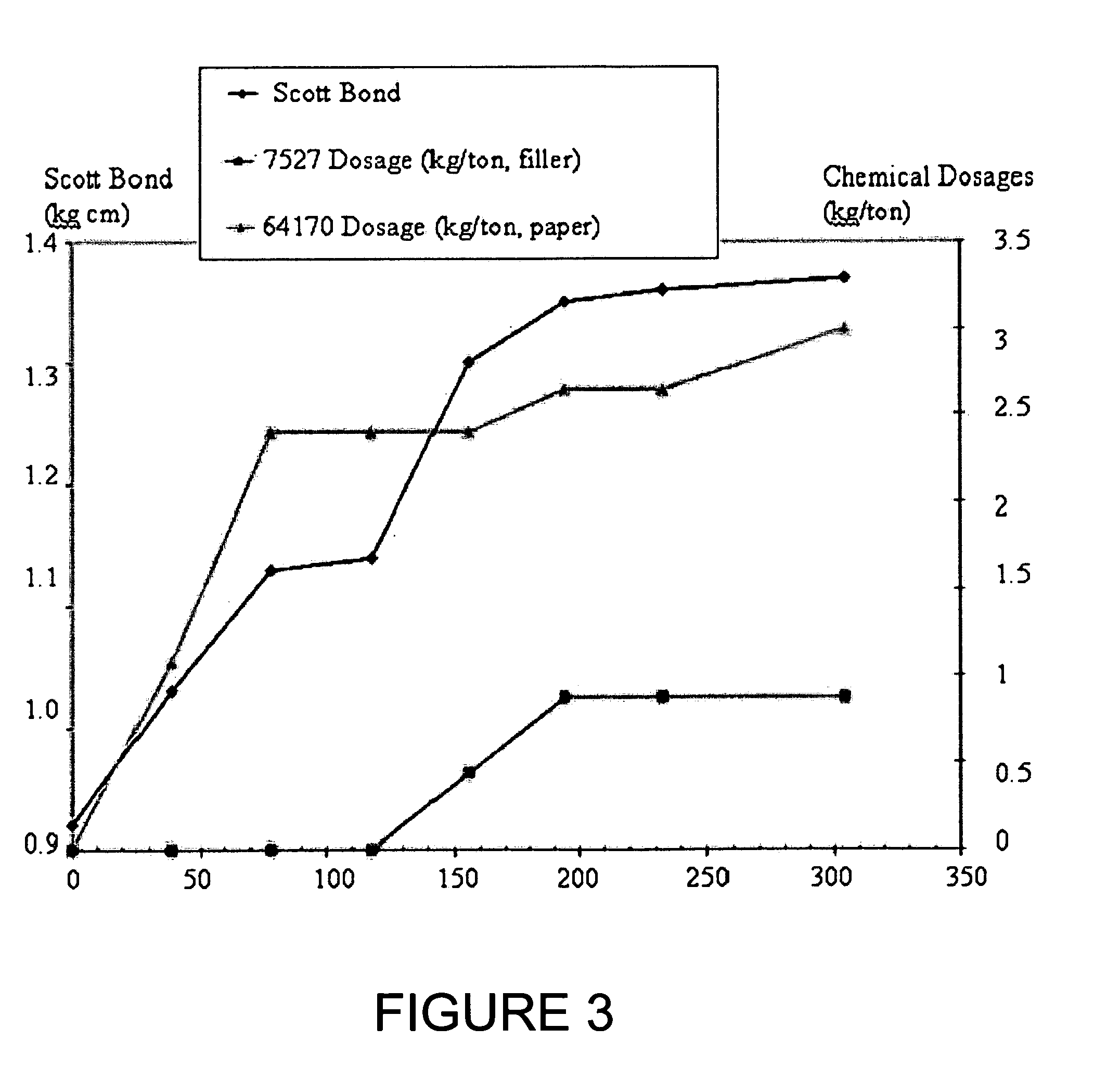Method of increasing filler content in papermaking
a technology of filler content and papermaking, which is applied in the field of increasing the strength of paper mats, can solve the problems of increasing the filler content, affecting the number and strength of bonding, and increasing the amount of filler particles with a greater surface area, so as to prevent the effect of strength additiv
- Summary
- Abstract
- Description
- Claims
- Application Information
AI Technical Summary
Benefits of technology
Problems solved by technology
Method used
Image
Examples
example 1
1(i) Filler Pre-Treatment
[0036]A blend of filler particles was obtained from a paper mill. The blend was a mixture of 50% PCC and 50% GCC. The PCC was un-dispersed Albacar HO (manufactured by Specialty Mineral of Bethlehem, Pa.), and the GCC (also manufactured by Specialty Mineral of Bethlehem, Pa.) was chemically dispersed. For purposes of this application, the definition of the term “un-dispersed” is distributed through a fluid without the aid of a chemical dispersant. For purposes of this application, the definition of the term “chemically dispersed” is distributed through a fluid with the aid of a chemical dispersant.
[0037]The filler blend was diluted to 18% solid content with tap water. 200 mL of the diluted filler blend was placed in a 500 mL glass beaker. Stirring was conducted for at least 30 seconds prior to the addition of coagulant. The stirrer was a EUROSTAR Digital overhead mixer with a R1342, 50 mm, four-blade propeller (both from IKA Works, Inc., Wilmington, N.C.). A ...
example 2
[0040]The cellulose mixture and filler were provided as in Example 1. The filler was treated as in Example 1. 3 kg / ton strength additive 64170 was added to three samples, one containing 100% PCC, one containing 50% PCC-50% GCC, and one containing 50% PCC-50% GCC with the GCC pre-treated with 7527. The resulting paper samples were analyzed and results were shown in FIG. 2, which plots tensile strength of a given paper versus the percentage of filler relative to the total solid portion of the paper mat used to produce the given paper.
[0041]When 3 kg / ton additive 64170 was added with 100% PCC, only 3% filler content could be increased without strength loss. At around 34% filler content, strength improved 12%. When 100% PCC was switched to 50% PCC-50% GCC, strength increased and it could allow a 3.5% filler content increase without losing sheet strength. When 3 kg / ton additive 64170 was added, about another 2.5% filler content could be increased without sacrificing sheet strength. At 35...
example 3
[0042]A machine trial was run in which a papermaking machine made 108 gsm coated base paper with machine speed of 1360 m / min. A composition was provided whose cellulose fibers were 40% Bleached Chemi-Thermo-Mechanical Pulp (BCTMP), 40% HBKP 40%, SBKP 20%. The furnish also contained a filler blend which was 70% PCC and 30% GCC. During the trial, all the wet end additives including retention aids, sizing agents, and cationic starches were kept constant. The resulting paper strength was measured using a Scott Bond tester.
[0043]FIG. 3 shows the resulting Scott Bond strengths of paper blends that included 8 blends that have various amounts of 7527 and 64170. When no 7527 and no 64170 were added, the strength was 0.92 kg cm. When 2.5 kg / ton of 64170 was added, the strength increased to 1.14 kg cm, a 24% strength improvement. Upon the further addition of 0.5 kg / ton of 7527 however the strength increased from 1.14 kg cm to 1.30 kg cm a further 14% improvement. This trial demonstrated that w...
PUM
| Property | Measurement | Unit |
|---|---|---|
| speed | aaaaa | aaaaa |
| strength | aaaaa | aaaaa |
| composition | aaaaa | aaaaa |
Abstract
Description
Claims
Application Information
 Login to View More
Login to View More - R&D
- Intellectual Property
- Life Sciences
- Materials
- Tech Scout
- Unparalleled Data Quality
- Higher Quality Content
- 60% Fewer Hallucinations
Browse by: Latest US Patents, China's latest patents, Technical Efficacy Thesaurus, Application Domain, Technology Topic, Popular Technical Reports.
© 2025 PatSnap. All rights reserved.Legal|Privacy policy|Modern Slavery Act Transparency Statement|Sitemap|About US| Contact US: help@patsnap.com



